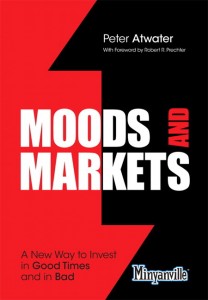With one more month of summer to go, why not spend it catching up on some of the best financial books of the season? This is Book Week on TRB, a new one each day that you may have missed and should definitely buy/download.
Today I’d like to turn you on to a brand new book by Peter Atwater called Moods and Markets. You may recognize Atwater’s name from Minyanville where he is a frequent contributor. It is my opinion that sentiment and social mood have huge implications and even predictive properties when used as a lens through which to view markets. Peter is one of the foremost authorities on this topic. His work as President of consulting firm Financial Insyghts is geared toward advising policy makers, institutions and corporations on all things mood-related. This book is the culmination of his findings and it includes a ton of real-life uses for this knowledge as it relates to trading and investing.
Peter was nice enough to allow me to print the below excerpt from Chapter 6 of Moods and Markets, which I think is perfect for the current moment. Enjoy! – Josh
***
 Signs of a Bottom in Social Mood
Signs of a Bottom in Social Mood
During the 2008 banking crisis, David Rosenberg, then chief economist of Merrill Lynch (and now chief economist of Gluskin Sheff), offered, “Bear markets don’t end in hope; they end in despair.” I held on to this quote because it ran counter to what I believed at the time and to what I believe most investors still think. Yet it’s all too true. If self-assured certainty and overreaching are experienced at the top, then self-assured uncertainty, along with a dire sense of futility and hopelessness, must accompany the bottom.
You would think then that the characteristics of bottoms in social mood and confidence would simply be the opposite of what we witness at the top; that Big Truths would instead be seen as Big Lies; that instead of an abdication of risk management, there would be a near-coronation of it; that complexity would be replaced by simplicity; that novice and naïve entrants would have completely exited and that the only ones left standing would be long-time, experienced, and sophisticated participants; that excessive credit would be replaced by excessive equity and a complete unwillingness to borrow and lend; and that instead of constructing new buildings, we would instead be tearing them down.
All of these opposite elements are in fact true characteristics of a bottom, but I am afraid that they don’t quite capture the real essence as to why that would be the case.
Extreme “Me, Here, Now” Behaviors
As I noted at the beginning of the book, bottoms in confidence reflect not only uncertainty, but self-assured uncertainty. To borrow Dave’s line from this chapter’s introduction, at the bottom despair reigns and there is an omnipresent sense that we don’t know what, if any, good the future will bring. It is a state of fear-filled delusion that we see as a long-lasting, if not permanent, condition.
The net result, though, is that our decisions and actions reflect extreme “me, here, now” choices. At the bottom generosity is replaced with selfishness and self-interested behavior as it is my, not our, survival that matters most to me. In addition, what was once viewed as offering permanent certainty— such as wealth and income—is now not only temporary, but even the time span of temporary is uncertain. It could be a day, a week, or a month. Who knows? At the bottom, I not only believe that the rug may be pulled out from under me, but I have come to expect it. What happens on a national, let alone international level, is also almost meaningless to me. As I noted in Chapter 1, “Understanding Social Mood,” when we are most fearful our worlds are very small. Everything is local and we want the people and things that are most important to us to be close—extremely close.
Having reflected on self-assured uncertainty for some time, I believe that better than any of the “opposite” elements I listed, perhaps the best characteristics of a trough in confidence can be captured in the words “hoarding” and “sacrifice.”
Before discussing both of these traits, let me reinforce that like the saturated sensation of self-assured certainty that we feel at the top, at the very bottom there is an
equivalent sensation of saturating self-assured uncertainty. That is to say that there is a consistent “all-in” or “all-out” sentiment that is shared. Again, and importantly, it is shared up and down the entire food chain. For a specific company, not only must investors feel self-assured uncertainty regarding the future prospects of the company, but so too must suppliers, creditors, analysts, managers, and so on. All must feel a sense of hopelessness. (And, in light of current events in Europe, let me note here that these same characteristics also apply to countries and governments as well.)If this feels like the moment just before bankruptcy, that is because it often is. In truly extreme troughs, bankruptcy, if not outright liquidation, is what naturally results when there is a saturating collective absence of hope. I hope that by offering this extreme scenario you can get a feeling for the sensation of the mood that accompanies bottoms that I am trying to describe.
Hoarding Behaviors
With that sense of uncertainty in mind, let me turn to hoarding. I suspect that when some of you read the word hoarding your minds immediately turned to the runs on the banks experienced in the U.S. during the Great Depression. (And, yes, those runs really did correspond to the extraordinary sense of uncertainty that accompanied the market/social mood bottom.) But I encourage you to think of hoarding much more broadly than just the natural urge to hold physical cash as mood deteriorates and to consider the word in the context of generosity. As mood deteriorates toward the bottom, all aspects of our generosity (financial, social, emotional, political, and so on) toward others drops dramatically. In some extreme cases it even ceases to exist.
When presented in this light, I suggest that it opens a broad range of actions that reflect, for example, that at the bottom there is no benefit of the doubt given. Not surprisingly, at a bottom you often see shareholders replace directors, and boards replace executive leadership. Similarly, you see companies shutter a troublesome business unit or stop manufacturing a supposedly “flawed” product at a trough.
Also note that as markets approach bottoms, governments behave with self-interestedness comparable to the private sector. As do voters at the polls. Extremes in nationalism and isolationism, not to mention regulation and even authoritarianism, are normal natural accompaniments to what is witnessed in the corporate environment during periods of extreme self-assured uncertainty. As public sector actions often receive far more attention in the media than what happens in business, I strongly encourage investors to also consider the nature of major policy decisions in their assessment of mood, particularly in down markets. Again, changes in social mood affect all aspects of the world around us, and there may be no group more reactive to those changes than politicians and public policymakers.
If bear markets end in despair, then at the bottom we act desperately. But what is particularly interesting to me about moments of peak self-assured uncertainty is how our desperate actions are all specifically focused on doing something to end our state of hopelessness. To me this is why investors naturally sell losing stocks at the bottom. With intense hopelessness, there is an acute need to do something—in some cases literally anything—to create a renewed level of certainty. I contrast this to market tops where we want things to go on forever (and certainly want to believe that they will). With bottoms, there is much more of a saturating “Make it stop right now!” quality. At the very bottom, we want it to be over immediately.
***
Thanks, Peter!
Buy the book here:
And follow Peter on Twitter here:
https://twitter.com/Peter_Atwater




… [Trackback]
[…] Find More Information here to that Topic: thereformedbroker.com/2012/08/06/book-week-moods-and-markets/ […]
… [Trackback]
[…] Find More to that Topic: thereformedbroker.com/2012/08/06/book-week-moods-and-markets/ […]
… [Trackback]
[…] Here you can find 3650 more Info to that Topic: thereformedbroker.com/2012/08/06/book-week-moods-and-markets/ […]
… [Trackback]
[…] Find More on to that Topic: thereformedbroker.com/2012/08/06/book-week-moods-and-markets/ […]
… [Trackback]
[…] Info on that Topic: thereformedbroker.com/2012/08/06/book-week-moods-and-markets/ […]
… [Trackback]
[…] Read More here on that Topic: thereformedbroker.com/2012/08/06/book-week-moods-and-markets/ […]